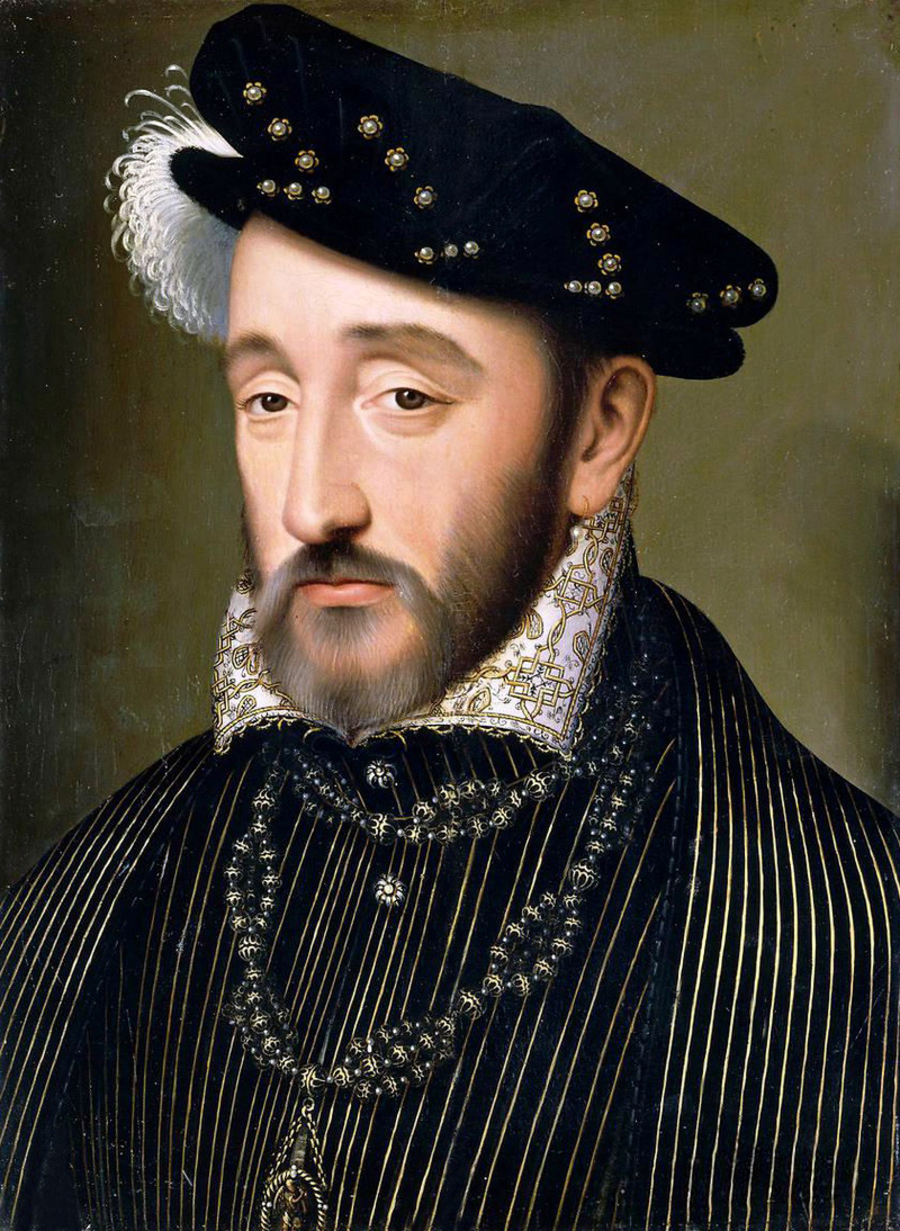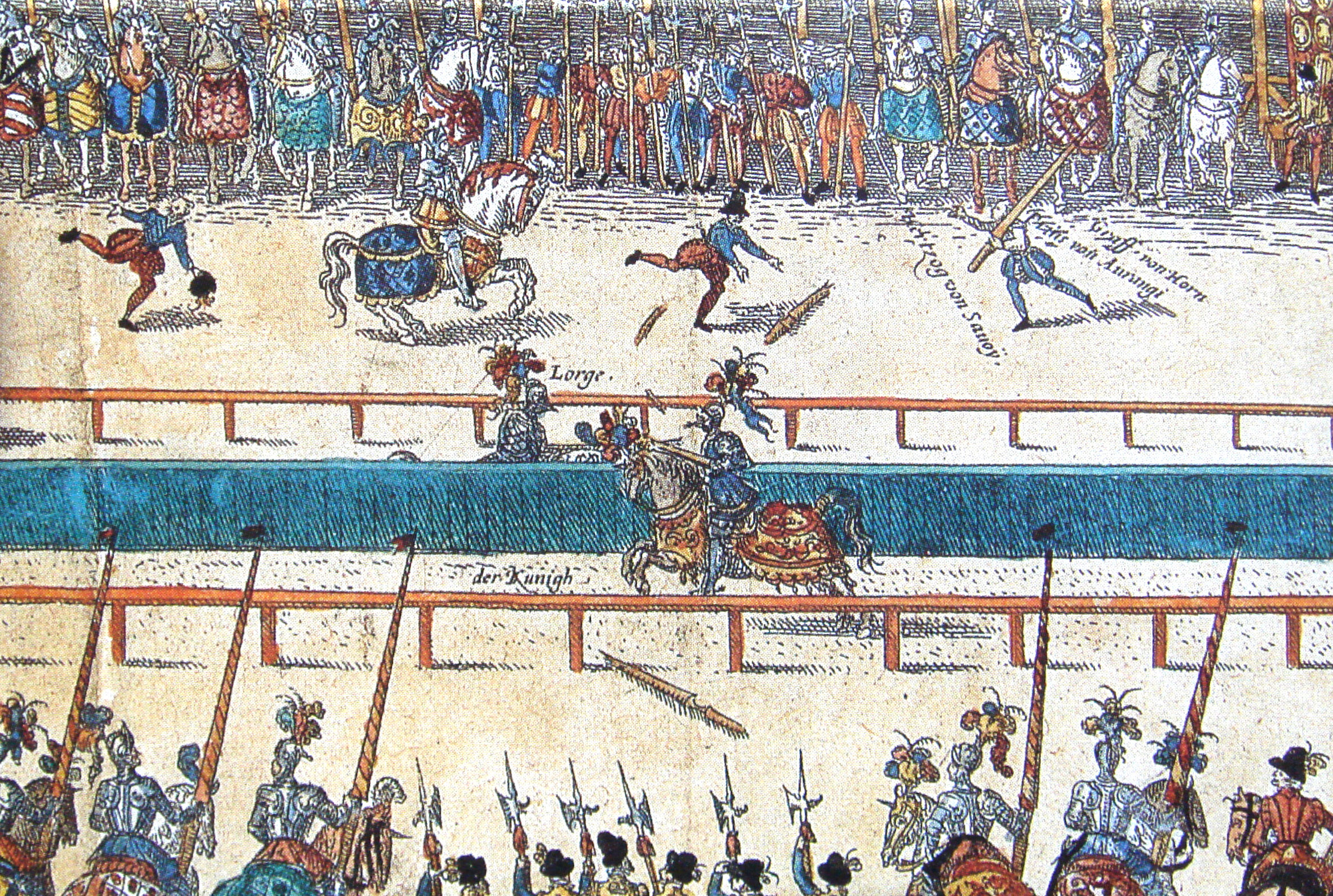by Susan Flantzer © Unofficial Royalty 2013

King Henri II of France, Credit – Wikipedia
“The young lion will overcome the older one,
On the field of combat in a single battle;
He will pierce his eyes through a golden cage,
Two wounds made one, then he dies a cruel death.”
The above quatrain by Nostradamus, a French apothecary and reputed seer, is often interpreted as predicting the death of King Henri II of France. The interpretation usually goes something like this: King Henri II of France (older one) jousted Gabriel de Lorges, Comte de Montgomery, captain of his Scotch Guard (young lion), who was eleven years younger, during a tournament (field of combat). Both had lions on their shields. In their final pass, Montgomery’s lance tilted up, and went through Henri’s visor, splintering into pieces. Two shards, one through the eye (pierce his eyes through a golden cage), and one through the temple, lodged in Henri’s head (two wounds made one). Henri suffered for eleven days (then he dies a cruel death) before dying.
King Henri II of France was born on March 31, 1519, at the Château de Saint-Germain-en-Laye, near Paris, France. He was the second son of King François I of France and Claude, Duchess of Brittany, who was a daughter of King Louis XII of France and Anne, Duchess of Brittany.
Henri had six siblings:
- Louise (1515 – 1517), died in childhood
- Charlotte (1516 – 1524), died in childhood from measles
- François III, Duke of Brittany (1518 – 1536), unmarried, succeeded his mother Claude as Duke of Brittany, died aged 18
- Madeleine (1520 – 1537), married James V, King of Scots (1st wife), no children, died six months after the marriage from tuberculosis
- Charles II, Duke of Orléans (1522 – 1545), unmarried, died at age 23
- Marguerite of France, Duchess of Berry (1523 – 1574), married Emmanuel Philibert, Duke of Savoy, had one son

Catherine de Medici, Queen of France; Credit – Wikipedia
Due to her wealth, Catherine de Medici, the daughter of Lorenzo II de Medici, Duke of Urbino and Madeleine de La Tour d’Auvergne, had several potential bridegrooms. Both her parents had died before she was one month old and she was raised by various members of the wealthy banking family and political dynasty, the House of Medici. The Medici family jumped at the offer of François I, King of France to marry her to his second son Henri, the Duke of Orléans.
At this time, Henri’s elder brother François III, Duke of Brittany, Dauphin of France was the heir to the throne and there was little prospect of Henri becoming King of France. The two fourteen-year-olds were married at the Église Saint-Ferréol les Augustins in Marseille, France on October 28, 1533. Henri paid little attention to Catherine during the first ten years of their marriage, preferring mistresses, particularly Diane de Poitiers who became Henri’s mistress when he was fifteen and she was 35 years old. She remained Henri’s mistress for the rest of his life. Henri and his wife Catherine did not have any children until they had been married for nearly eleven years.

Henri, Catherine, and their children; Credit – Wikipedia
Eventually, they had ten children, seven surviving to adulthood.
-
- François II, King of France (1544 – 1560), married Mary, Queen of Scots, no children
- Elisabeth of Valois, Queen of Spain (1545 – 1568), married King Felipe II of Spain, had two daughters
- Claude of Valois, Duchess of Lorraine (1547 – 1575), married Charles III, Duke of Lorraine, had nine children
- Louis, Duke of Orléans (1549 – 1550), died in infancy
- Charles IX, King of France (1550 – 1574), married Elisabeth of Austria, had one daughter died young
- Henri III, King of France (1551 – 1589), married Louise of Lorraine, no children
- Marguerite of Valois, Queen of France and Navarre (1553 – 1615), married Henri III, King of Navarre, the future Henri IV of France, no children
- Hercule François, Duke of Anjou (1555 – 1584), unmarried
- Victoria of Valois (born and died 1556), twin of Joan, died in infancy
- Joan of Valois, twin of Victoria, died in utero
In 1536, Henri’s elder brother François, the Dauphin (the title of heir to the French throne) and Duke of Brittany died at the age of 18. There were suspicions that he was poisoned, but he probably died from natural causes, most likely from tuberculosis. Henri became the heir to the throne and succeeded his father on March 31, 1547, his 28th birthday. He was crowned King of France on July 25, 1547, at Reims Cathedral. Henri’s reign was marked by the Italian Wars against the House of Habsburg and the suppression of the Protestant Reformation, particularly the persecution of the Protestant French Huguenots, who were becoming a large minority.
On June 30, 1559, a great celebration and tournament were held in Paris at the Hôtel des Tournelles (now the site of the Place des Vosges) in honor of the Peace of Cateau-Cambrésis with France’s longtime enemies, the Habsburgs and the two marriages that occurred as a result of the Peace: Emmanuel Philibert, Duke of Savoy marrying Henri’s sister Marguerite of France, Duchess of Berry and King Felipe II of Spain marrying Elisabeth, the eldest daughter of Catherine and Henri II.
King Henri II, at age 40, still liked to participate in tournaments even though he had been advised not to participate because of dizziness after physical exertion. Henri and Gabriel de Lorges, Comte de Montgomery, captain of the Scotch Guard jousted and Henri had been almost unseated from his horse. He insisted upon a rematch despite the urgings of his wife, the Duke of Savoy, and other friends to stop. The Comte de Montgomery reluctantly agreed to participate. de Montgomery’s lance struck the king’s helmet, splintered, and went through the visor going through the king’s right eye and through his temple into the brain. The king, bleeding profusely and nearly unconscious, was carried into the Hôtel des Tournelles.

Tournament between Henri II and Lorges, Credit – Wikipedia
Henri received Immediate treatment from the court physicians and renowned surgeon Ambroise Paré. The splinter from the king’s eye was removed and he was bled as that was the medical practice at the time. It was hoped that losing an eye would be the worst thing to happen. King Felipe II of Spain arranged for one of his personal physicians, the great Belgian anatomist Andreas Vesalius, to go to Paris from Brussels for a consultation. Vesalius arrived on July 3, 1559, and determined that the king would not recover. Queen Catherine, desperate to find a way to cure her husband, had four criminals beheaded and then had splintered lances poked through the eyes at the same angle the lance had gone through Henry’s eye. Henri’s condition continued to worsen. On July 9, he was given the last rites and he died on July 10, 1559, at the age of 40, probably from a subdural hematoma and sepsis.

Deathbed of King Henri II of France, Credit – Wikipedia
King Henri II of France was buried at the Basilica of Saint-Denis near Paris, the traditional burial place of French royalty. During the French Revolution, Henry’s coffin was removed and thrown into a mass grave with the remains of other French royals. However, the tomb of Henri II and Catherine de Medici can still be seen at the Basilica of Saint-Denis. In 1817, the mass graves containing the royal remains were opened and the remains were then placed in the crypt of the basilica. Nearby are several large metal plates bearing the names of those royals whose graves had been desecrated during the French Revolution.
France Resources at Unofficial Royalty
This article is the intellectual property of Unofficial Royalty and is NOT TO BE COPIED, EDITED, OR POSTED IN ANY FORM ON ANOTHER WEBSITE under any circumstances. It is permissible to use a link that directs to Unofficial Royalty.

